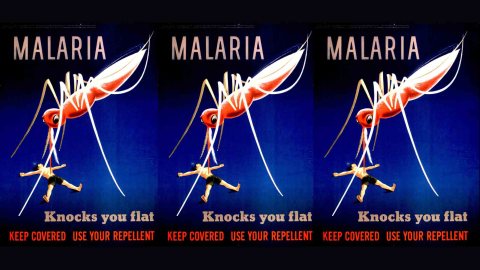After 12 Bouts with Malaria, One Doctor Mounts Math-Driven Vaccine Campaign

Malaria is one of the worst diseases ever to affect mankind. Horrible in its symptoms, with a high death rate for the untreated, and a record of horrible waste and misery in areas where it is endemic. A vaccine has proven notoriously difficult to create, drug and pesticide resistance is an ever growing problem, and the best prevention methods require extensive cooperation between communities and health care providers.
How can we solve a problem like Malaria? One doctor has an idea: send in the mathematicians.
Dr. Philip Eckhoff, who holds a PhD from Princeton University in applied and computational mathematics, uses math to fight the disease which bothered him so much growing up in Haiti. Dr. Eckhoff had malaria more than a dozen times before he went to college in the United States. Those experiences later sparked his avid interest in malaria and global public health.
At the Institute for Disease Modeling, where Dr. Eckhoff is Principal Investigator, his math skills are put to excellent use in computer modeling. He has created mathematical models that predict how to best battle the disease in every locale. The models can account for many factors in a given location, such as when mosquitoes are most active and how resistant they are to pesticides, and then predict the effectiveness of various treatment options such as drugs, bed netting, and spraying in that area. The modeling can help explain why some areas have proven more difficult to clear of the disease than others. For this work Philip was made a Hertz Fellow in 2009.
Describing his work, he explains:
“When we model a disease, there’s a couple of questions that we’re interested in. And there are many different possible approaches and many different ways to actually model a disease, whether it’s through agent-base modeling — where you run a simulation where each individual person, locations, et cetera are software objects — and you create the rules by which they interact. You can also do this through differential equations. You can use a whole set of different approaches to actually get at a realistic answer and helpful answer. But one of the most important pieces is actually understanding what the question is because out of all the different approaches for mathematical modeling a disease there might be one that’s best suited given a question. So one of the questions that my group at the Institute for Disease Modeling has been spending a lot of time on is how do we combine different interventions to actually get rid of malaria in a given setting. Malaria will be very different from place to place depending on what mosquitoes are there to transmit.”
With models like this, ideas that have not been working in a given area can be replaced with ones that have a high probability of working like a charm. Ideas that may not have occurred to aid workers can be suggested. Even a minor improvement in the effectiveness of treatment can save lives.
But Dr. Eckhoff aims a little higher. He wants to completely eradicate malaria.
It won’t be easy. After all, we tried and failed to do this sixty years ago. The fight will be an interdisciplinary one; with aid workers, vaccine producers, drug companies, local doctors, and pest controllers working in tandem. If one group can’t solve part of the problem, perhaps another kind of mind can. Where one group is unable to provide a solution, another will. If the problem seems to large for any one field of experts, they can just make it a larger problem and bring in another team to help.
“On a problem like malaria eradication — disease eradication in general — getting rid of infectious diseases is very fundamentally an interdisciplinary problem. There will be people from the medical side of things. There will be people from health systems and operations. People who know immunology, drug development, vaccine development, mosquito science, entomologists and vector biologists, people who understand ecology. At the same time there’s also a really good role for people who are good at mathematics, people who are good at software, people who are good at data systems.”
By using mathematical modeling, these groups of people can each be used in the most effective way possible. Saving hundreds of thousands of lives.Will mathematical modeling be the death knell for Malaria? A disease that has plagued mankind for 10,000 years? Dr. Eckhoff thinks it will be.
“Eradicating polio worldwide within five years and ending malaria in most countries within 20 to 30 years are realistic goals,” but he warns, “No matter how many times we eradicate malaria or another disease in our simulation models, unless the recommendations are put into practice at the local level, we won’t effect change.”





